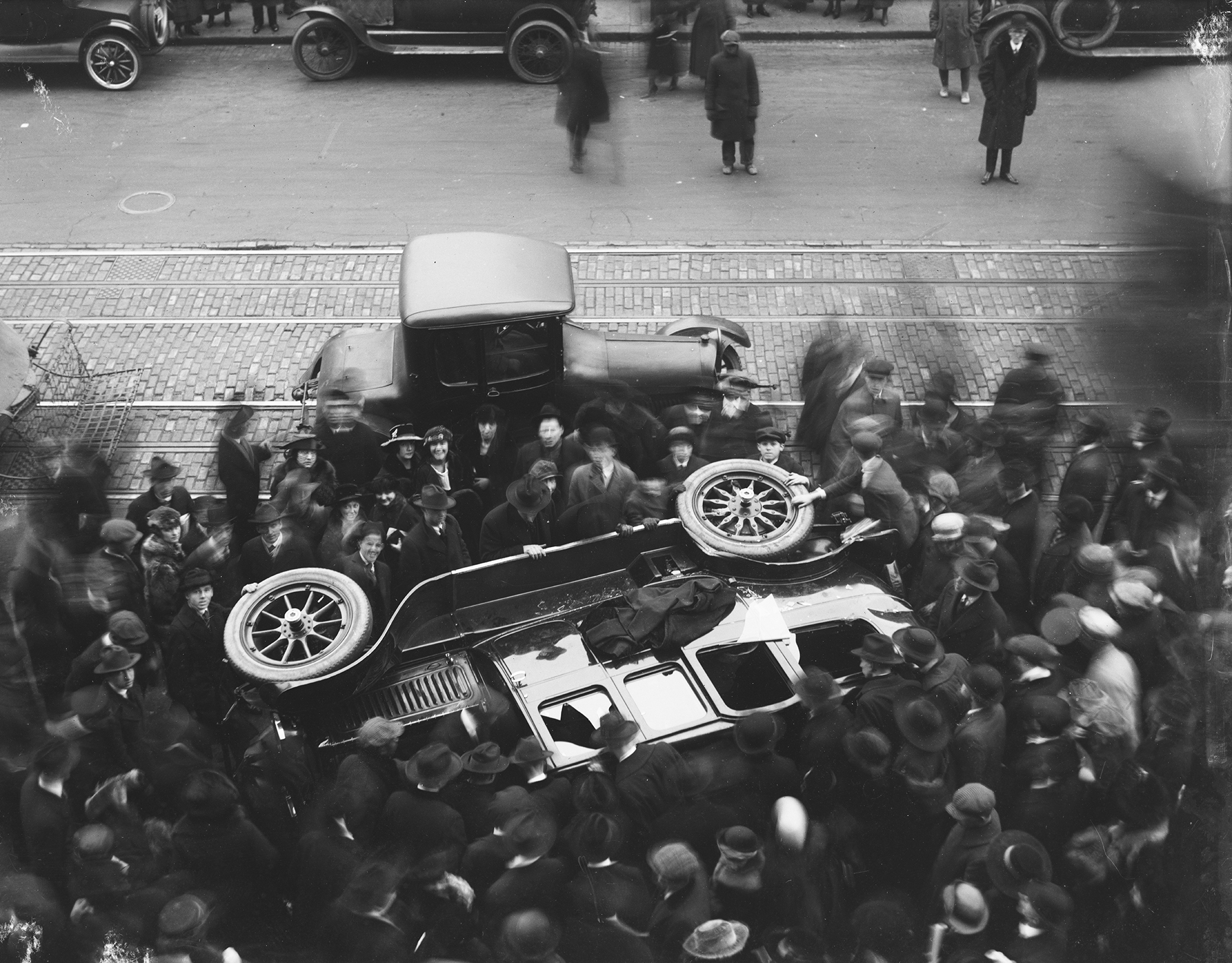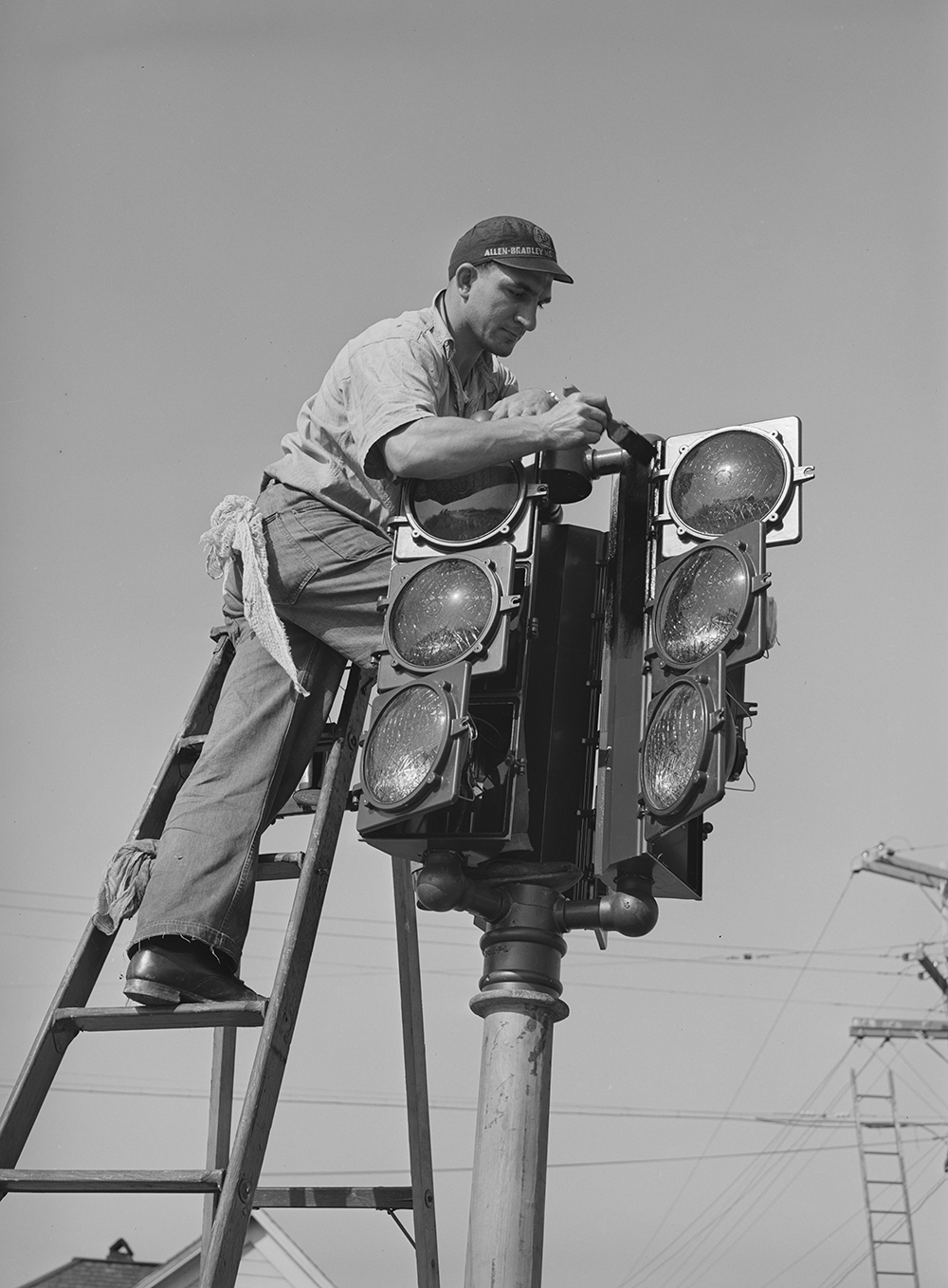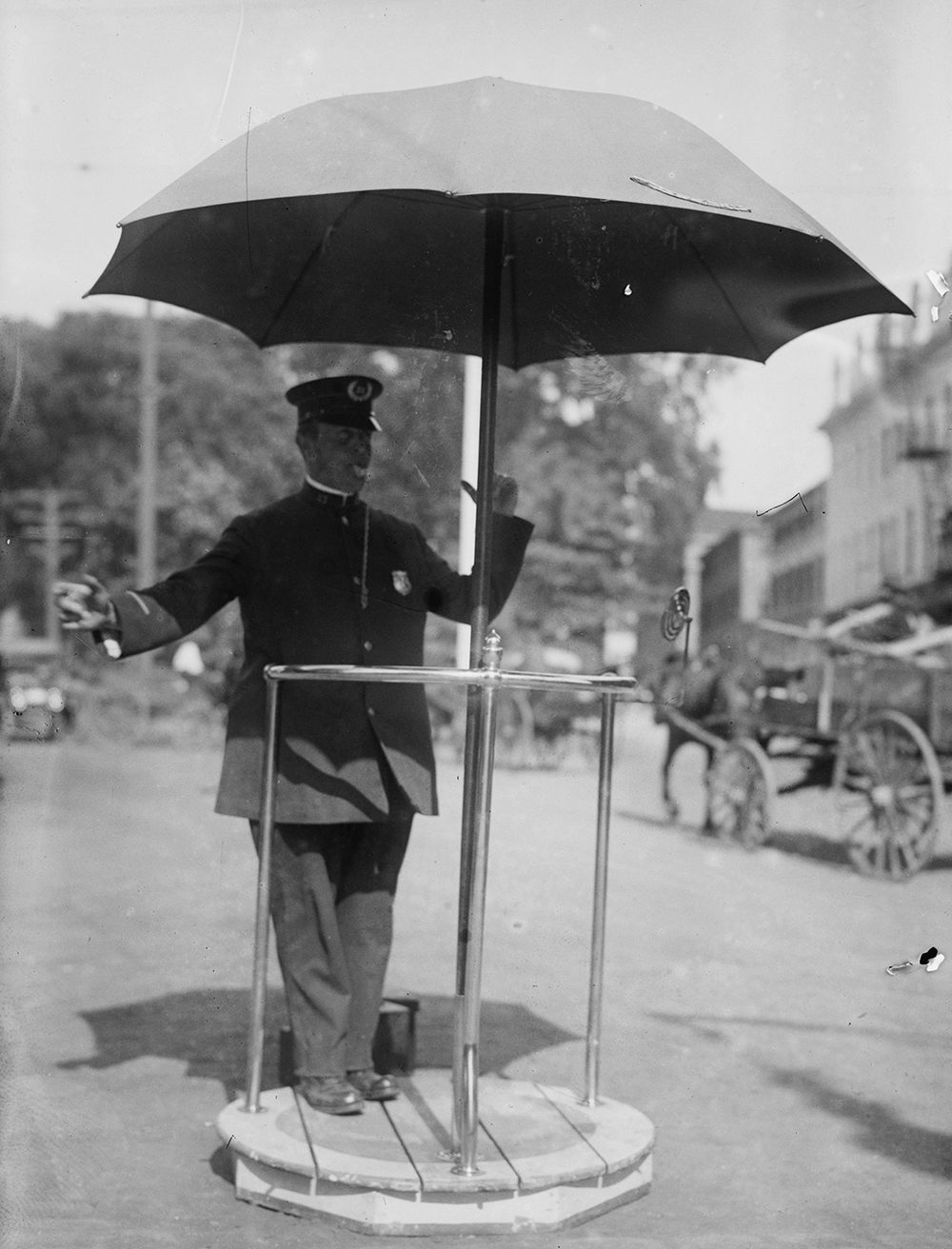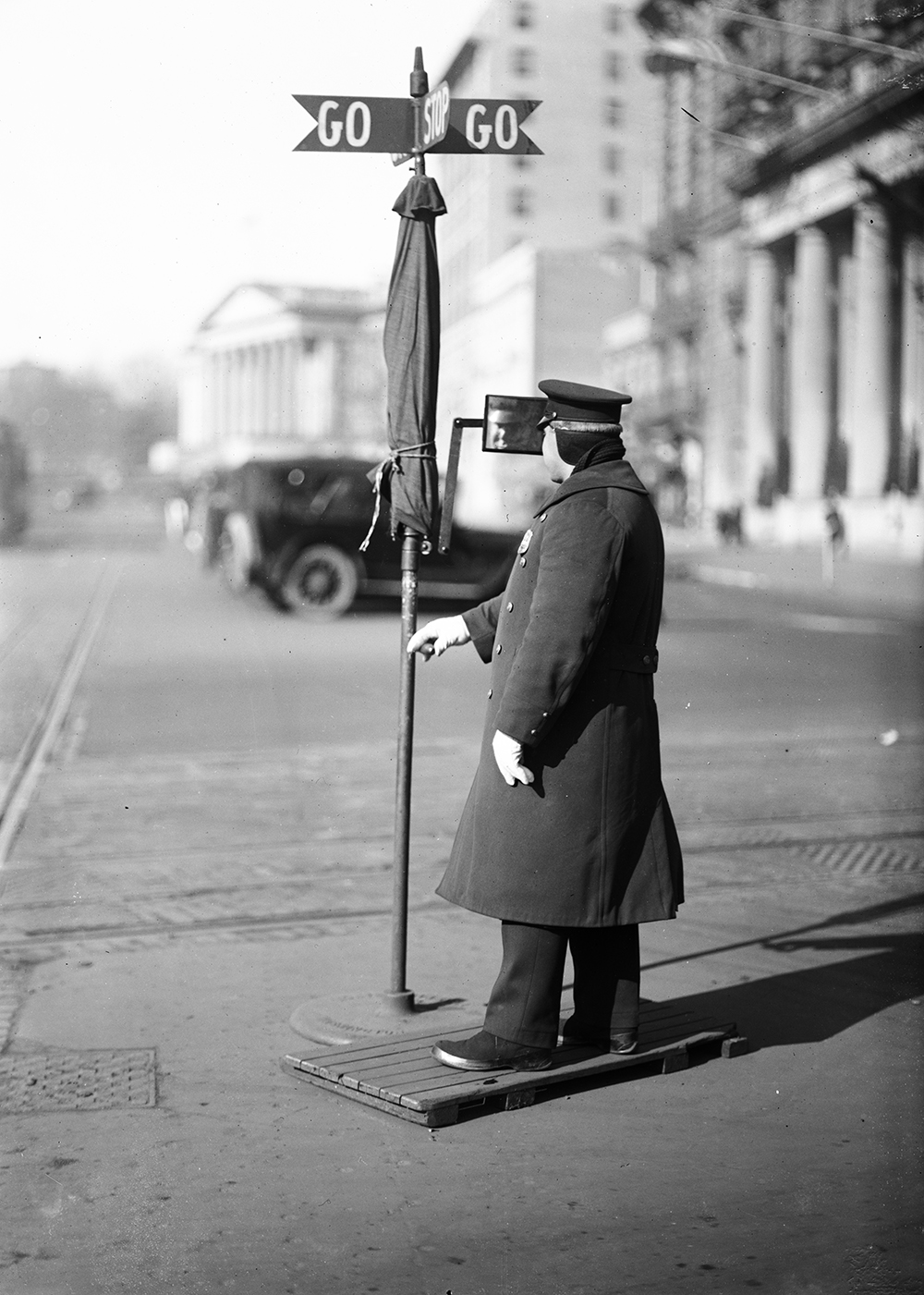
Crowd surrounding overturned automobile, c. 1915. Photograph by Harris & Ewing. Library of Congress, Prints and Photographs Division.
America was not ready for the mass production of the automobile. At the turn of the century, thousands of motorized vehicles on Main Streets originally intended for pedestrians and horse-drawn carriages suddenly choked intersections and gave new meaning to the word traffic. Before mass-produced cars, even New York City’s Broadway had provided enough space that carriage drivers usually did not hesitate before making a turn. Afterward, they had to contend with horseless carriages for every square inch. Narrower streets, many unpaved, simply could not handle the traffic that piled up, and municipal officials were caught unprepared to deal with the chaos.
Movement stalled in every town large enough to have a commercial district, prompting then U.S. secretary of commerce Herbert Hoover to declare a national crisis. “Are we consuming the new living conveniences faster than we can digest them?” he questioned. “Are we not like one who overeats?”
These “machines,” as cars were sometimes called in the early years, also posed an unprecedented threat to public safety. Pedestrians accustomed to horses trotting on roads at about five to ten miles per hour were taken aback by motor-powered vehicles whose speed was limited—by law, not by mechanics—to between thirty and fifty miles per hour. Even drivers seemed surprised by how fast they could go, judging by the number of accidents that occurred from failure to slow down when turning corners. So were horses that were easily startled by the noises that cars made, which created another hazard. The previously mundane act of crossing the street or walking on the sidewalk now risked life and limb. Stories appeared regularly in newspapers of cars jumping curbs, plowing into pedestrians, and violently flinging bystanders. Automobile fatalities had become so common that by 1935, a reporter for Harper’s Monthly magazine declared, “In these deaths by motor cars, there was no news.”
The first response of local governments confronting traffic snarls and car accidents was to do what they had always done: pass laws based on their well-established “police power,” a legal concept that referred to a sovereign’s inherent power to regulate for the public’s health, safety, and welfare. That was exactly what the Fresno Board of Supervisors did when it limited automotive speed to thirty miles per hour. To enforce the speed limit, the board posted a sign that read:
motorists attention!
you are on your honor
fresno county has no speed cops
drive so they will not be needed
speed limit 30 miles per hour = board of supervisors
In 1916 the Iowa State Highway Commission lobbied for a similar enforcement plan after hearing that it was “working splendidly” in Bucyrus, Ohio, because the “reasonable motorist is ashamed to drive other than moderately.” But the experiment with the honor system was short-lived. Later that year, Popular Mechanics reported that “a traffic officer was again resorted to” in Fresno County and that the signs were “now for sale” after too many motorists “apparently interpreted [the signs] to mean that road races were in order and that their engines alone determined the speed limit.”

Nineteenth-century enforcement tools proved disastrously inadequate in the anonymous, fast, and crowded world of automobility. In the search for solutions to the death and mayhem wrought by mass-produced cars, officials everywhere grappled with a fundamental puzzle: why did law-abiding citizens disobey traffic laws?
In 1924 dean of Harvard Law School Roscoe Pound reminisced about the days of horses and buggies, when traffic had been governed in the same way as every other human activity. The “law said to us a very simple thing: adhere to the standard of what a reasonably prudent man would do, at your peril of liability in case you guess wrong.”
“In the old days there was no such thing as a jaywalker,” he recalled, because one “could cross the street wherever you pleased, subject to your liability for negligence.” Pound’s invocation of “the old days” betrayed a bit of nostalgic exaggeration. Even in the nineteenth century, at least in denser urban areas, local ordinances had regulated traffic, which included speed limits for horses on public streets, typically around eight miles an hour. In the 1870s, Los Angeles began experiencing a bit of traffic, so its police chief was tasked with “prohibiting the grazing or herding of cattle in the streets.” For fiscal year 1902, police in Los Angeles made a total of thirty-nine arrests for “fast driving.”
With “the advent of automobiles, motor trucks, pleasure vehicles, and motorcycles,” Pound noted, “the law cannot exactly say to us, well, both of you fellows guess at your peril, and if you guess wrong, one or both of you will have to answer.” To be sure, injured parties in car accidents continued to sue for tort damages, as a fourteen-volume treatise on the law of automobiles, first published in 1927, indicates. But the sheer number of cars required constant coordination even when the unrelenting chaos did not amount to litigable claims. As Pound observed, a “freedom of that kind” that had existed before now “impedes traffic, it imperils life, it creates an impossible tangle in our highways.”
Local governments responded swiftly by enacting laws and more laws. In addition to speed limits and license requirements, new regulations mandated safety equipment, like nonglaring headlights, rearview mirrors, and, in Massachusetts, at least two brakes for cars with horsepower greater than ten. They also prohibited motorized vehicles on certain roads; determined who among cars, horses, carriages, and pedestrians had the right of way; and specified how fast a car could overtake horse-drawn coaches and trolleys. According to one legal eagle, San Francisco even regulated “the angle at which motorists should make turns from one street into another.” In a short time, the number of regulations multiplied exponentially. In 1905, three years before the introduction of Ford’s Model T, a treatise on municipal corporations mentioned the automobile in just one line: “Bicycles, tricycles, and automobiles are ordinarily considered vehicles and entitled to the use of that part of the street or highway set aside for them.” Tellingly, another treatise published just seven years later, in 1912, devoted two entire sections to the regulation of “the running of automobiles.” An observer in 1920 noted that the “enormously increased traffic has given birth to laws that are now almost countless,” to the point that they could “fill a separate manual to overflowing and their number is added to at each session of the legislatures.”

“When will they end?” he groaned. “Is it to be wondered at that the adjournment of Congress and the state legislatures brings a universal sigh of relief?” another commentator wrote more sarcastically. “So numerous [were] the…laws regulating traffic,” a police chief asserted in 1936, “that few indeed are the persons who can travel the streets or highways without violating one or many of them every hour of the day.” Suddenly, misdemeanors became mainstream. Violations were committed “up town, down town, all around town,” one New York paper rhymed. Another reporter from the Empire City explained this phenomenon based on his personal experience getting a driver’s license in 1921. The written portion of New York’s application included the following questions: “Are you thoroughly familiar with the New York State Motor Vehicle law? General Highway Traffic law? New York City Traffic Ordinances and Police Traffic Regulations?” The New York Times writer’s cheeky response was: “Who is?”—confirming the reality that no one knew, and therefore no one could obey, all the laws. Right before his road test, a fellow applicant advised him to watch out if the examiner “tells ye to pull up. Chances are ye’ll be ’longside a fire hydrant.” “Why that?” the writer inquired “innocently.” He learned right then and there that it was against the law to stop within fifteen feet of a hydrant. A traffic engineer for the state of Massachusetts, extrapolating from an early 1930s study of a typical intersection and assuming similar conditions at all other intersections in the same city, concluded that approximately 2.5 million traffic violations occurred daily. The proliferation of traffic laws had turned everyone who drove a car into a lawbreaker.
Even Herbert Hoover “doesn’t always obey his own safety rules,” the papers reported in 1925, back when he was secretary of commerce and was heading the national movement for street and highway safety. “Dressed in immaculate white flannels and blue coat,” he was spotted jaywalking on H Street, near the Commerce Building, having “wormed his way thru one lane of parked cars.” He stepped out “directly in the path of a big limousine,” which had to slam to a sudden halt to allow “the distinguished safety expert” to “narrowly escape being run over.” Hoover, of all people, would have known the statistics identifying lawbreaking pedestrians as one of the leading causes of auto accidents.
Notwithstanding the democratizing appeals of mass-produced cars, the media racialized drivers from the automobile’s earliest years. Not many African Americans owned or drove cars in the 1910s and 1920s, although exactly how many is uncertain. No statistic on black car ownership existed until the mid-1930s, even though the U.S. Census Bureau had been keeping track of information like “Type of Access Road Leading to Black Farms by Farm Location” (there were nine types). From this, one can surmise the relative prevalence of black drivers versus black farmers. In 1935 Atlanta, Georgia, one of the few cities that counted car ownership by race at the time, 17 percent of all black families had a car, compared with 63 percent of white families. For minorities, driving remained an elite prerogative until well after World War II.

Disregarding their respectability, white journalists, travel writers, and photographers often portrayed black drivers as incapable of handling the modern technology. When, in 1910, the legendary black boxer Jack Johnson—who had just defeated the “Great White Hope” Jim Jeffries in the “fight of the century”—challenged the top-ranked racecar driver Barney Oldfield, mainstream papers, the New York Times among them, highlighted his traffic violations to suggest that he was a reckless driver and a public threat. In 1913, Johnson was arrested twice and ultimately convicted of violating the Mann Act for transporting—presumably driving—a white woman, a former paramour, across state lines for “immoral purposes.” (He received a presidential pardon in 2018.) Black newspapers sought to counter stereotypes and bad press with profiles of successful black drivers, auto mechanics, inventors, chauffeuring entrepreneurs, and driving instructors. But most persuasive in convincing government leaders that traffic violations were not a “racial habit,” as one writer admitted, was the daily display of citizens of every race, ethnicity, age, and gender who committed them. Lawbreaking was done “by children and by adults; it is done by frolicking urchins, by dignified merchants, by heedless flappers, and by staid women of mature years,” the reporter observed. This perhaps explains why, unlike the ideations of white culture, official documents and discourses on the traffic problem rarely mentioned race.
When it came to self-reflection, most drivers did not consider themselves delinquent even when they violated the rules of the road. In the history of cars, law-abiding referred to upstanding traffic lawbreakers. Illustrating this belief was the response that the police often received: “I’m not doing any harm. Why don’t you catch a few burglars for yourselves instead of bothering good citizens?” Even the New Yorker who wrote candidly that no citizen followed all the traffic laws still believed that “the great majority of motorists…are honest, law-abiding, decent folks.” This dissonance was certainly not new. But in the early twentieth century, it frequently resulted in disaster, leaving policy makers bewildered that so many ordinary citizens resolutely disobeyed traffic laws. When police chief August Vollmer observed the main thoroughfares of Berkeley in the early hours of the day when there was no traffic, he found it “very difficult to conceive how accidents can occur on these streets.” Nothing in the conditions of the roads themselves foreshadowed scenes of collisions and pileups. Vollmer also did not think that mechanical issues, like “defective brakes, defective headlights, steering gear, and whatnot,” caused most accidents. From his daily observations, he came to the inescapable conclusion that the source of the problem was human.
Adapted from Policing the Open Road: How Cars Transformed American Freedom by Sarah A. Seo, published by Harvard University Press.
